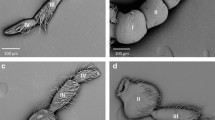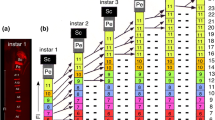Abstract
Sensilla lining the inner walls of the sacculus on the third antennal segment of Drosophila melanogaster were studied by light and transmission electron microscopy. The sacculus consists of three chambers: I, II and III. Inside each chamber morphologically distinct groups of sensilla having inflexible sockets were observed. Chamber I contains no-pore sensilla basiconica (np-SB). The lumen of all np-SB are innervated by two neurons, both resembling hygroreceptors. However, a few np-SB contain one additional neuron, presumed to be thermoreceptive. Chamber II houses no-pore sensilla coeloconica (np-SC). All np-SC are innervated by three neurons. The outer dendritic segments of two of these neurons fit tightly to the wall of the lumen and resemble hygroreceptor neurons. A third, more electron-dense sensory neuron, terminates at the base of the sensillum and resembles a thermoreceptor cell. Chamber III of the sacculus is divided into ventral and dorsal compartments, each housing morphologically distinct grooved sensilla (GS). The ventral compartment contains thick GS1, and the dorsal compartment has slender sensilla GS2. Ultrastructurally, both GS1 and GS2 are doublewalled sensilla with a longitudinal slit-channel system and are innervated by two neurons. The dendritic outer segment of one ofthe two neurons innervates the lumen of the GS and branches. On morphological criteria, we infer this neuron to be olfactory. The other sensory neuron is probably thermoreceptive. Thus, the sacculus in Drosophila has sensilla that are predominantly involved in hygroreception, thermoreception, and olfaction. We have traced the sensory projections of the neurons innervating the sacculus sensilla of chamber III using cobaltous lysine or ethanolic cobalt (II) chloride. The fibres project to the antennal lobes, and at least four glomeruli (VM3, DA3 and DL2-3) are projection areas of sensory neurons from these sensilla. glomerulus DL2 is a common target for the afferent fibres of the surface sensilla coeloconica and GS, whereas the VM3, DA3 and DL3 glomeruli receive sensory fibres only from the GS.
Similar content being viewed by others
References
Altner H, Loftus R (1985) Ultrastructure and function of insect thermo- and hygroreceptors. Annu Rev Entomol 30:273–295
Altner H, Prillinger L (1980) Ultrastructure of invertebrate chemo-, thermo- and hygroreceptors and its functional significance. Int Rev Cytol 67:69–139
Altner H, Sass H, Altner I (1977) Relationship between structure and function of antennal chemo-, hygro- and thermoreceptive sensilla in Periplaneta americana. Cell Tissue Res 176:389–405
Altner H, Tichy H, Altner I (1978) Lamellated outer dendritic segments of a sensory cell within a poreless thermo- and hygroreceptive sensillum of the insect Carausius morosus. Cell Tissue Res 191:287–304
Altner H, Schaller-Selzer L, Stetter H, Wohlrab I (1983) Poreless sensilla with inflexible sockets: a comparative study of a fundamental type of insect sensilla probably comprising thermo- and hygroreceptors. Cell Tissue Res 234:279–307
Ayer RK, Carlson J (1992) Olfactory physiology in the Drosophila antenna and maxillary palp: acj6 distinguishes tow classes of odorant pathways. J Neurobiol 23:965–982
Bacon JP, Altman JS (1977) A silver intensification method for cobalt-filled neurons in whole-mount preparations. Brain Res 138:359–363
Barrows WM (1907) The reactions of the pomace fly, Drosophila ampelophila Loew, to odorous substances. J Exp Zool 4:515–537
Boeckh J, Distler P, Ernst KD, Hösl M, Malun D (1990) Olfactory bulb and antennal lobe. In: Schild D (ed) Information processing of chemical sensory stimuli. Springer, New York Berlin Heidelberg
Bogner F, Boppré M, Ernst KD, Boeckh J (1986) CO2 sensitive receptors on labial palps of Rhodogastrica moths (Lepidoptera: Arctiidae): physiology, fine structure and central projection. J Comp Physiol [A] 158:741–749
Carlson J (1991) Olfaction in Drosophila: genetic and molecular analysis. Trends Neurosci 14:520–524
Christensen TA, Hildebrand JG (1987) Functions, organization and physiology of the olfactory pathways in lepidoperan brain. In: Gupta AP (ed) Arthropod brain: its evolution, development, structure and function. Wiley, New York, pp 457–484
Dalton AJ (1955) A chrome-osmium tetroxide fixative for electron microscopy. Anat Rec 121:281A
Ernst KD, Boeckh J, Boeckh V (1977) A neuroanatomical study of the the central antennal pathways in insects. II. Deutocerebral connections in Locusta migratoria and Periplaneta americana. Cell Tissue Res 176:285–308
Ferris CF (1965) External morphology of the adult. In: Demerec M (ed) Biology of Drosophila, 2nd edn. Hafner, New York, pp 368–419
Gödde J, Haug T (1990) Analysis of the electrical responses of antennal thermo- and hygroreceptors of Antheraea (Saturniidae, Lepidoptera) to thermal, mechanical, and electrical stimuli. J Comp Physiol [A] 167:391–401
Haug T (1986) Struktur, Funktion and Projektion dder antennalen Thermo- und Hygrorezeptoren von Antheraea pernyi (Lepidoptera: Saturniidae). Thesis, University of Regensburg
Homburg U, Christensen TA, Hildebrand JG (1989) Structure and function of the deutocerebrum in insects. Annu Rev Entomol 34:477–501
Itoh T, Yokohari F, Tanimura T, Tominaga Y (1991) External morphology of sensilla in the sacculus of an antennal flagellum of the fruit fly Drosophila melanogaster (Diptera: Drosophilidae). Int J Insect Morphol Embryol 20:235–243
Kaib M (1974) Die Fleisch- und Blumenduftrezeptoren auf der Antenne der Schmeißfliege Calliphora vicina. J Comp Physiol 95:105–121
Karnovsky MJ (1965) A formaldehyde-glutaraldehyde fixative of high osmolality for use in electron microscopy. J Cell Biol 27:137A
Kent KS, Harrow ID, Quartaro P, Hildebrand JG (1986) An accessory olfactory pathway in Lepidoptera: the labial pit organ and its central projections in Menduca sexta and certain other sphinx moths and silk moths. Cell Tissue Res 245:237–245
Lacher V (1964) Erektrophysiologische Untersuchungen an einzelnen Rezeptoren für Geruch, Kohlendioxyd, Luftfeuchtigkeit und Temperature auf den Antennen der Arbeitsbiene und der Drohne (Apis mellifera L.). Z Vergl Physiol 48:587–623
Lee JK, Selzer R, Altner H (1985) Lamellated outer dendritic segments of a chemoreceptor within wall-pore sensilla in the labial palp pit organ in the butterfly, Pieris rapae L. (Insecta: Lepidoptera). Cell Tissue Res 240:333–342
Loftus R (1976) Temperature-dependent dry receptor on antenna of Periplaneta: tonic response. J Comp Physiol 111:153–170
Mindek G (1968) Proliferations- und Transdeterminationsleistungen der weiblichen Genital-Imaginalscheiben von Drosophila melanogaster nach Kultur in vivo. Rouxs Arch Entw Mech Org 161:249–280
Nayak SV, Singh RN (1983) Sensilla on the tarsal segments and mouthparts of adult Drosophila melanogaster Meigen (Diptera: Drosophilidae). Int J Insect Morphol Embryol 12:273–291
Reynolds ES (1963) The use of lead citrate of high pH as an electron-opaque stain in electron microscopy. J Cell Biol 17:208–212
Riesgo-Escovar J, Woodard C, Gaines P, Carlson J (1992) Development and organization of the Drosophila olfactory system: an analysis using enhancer traps. J Neurobiol 23:947–964
Rodrigues V (1988) Spatial coding of olfactory information in the antennal lobe of Drosophila melanogaster. Brain Res 453:299–307
Siddiqi O (1983) Olfactory neurogenetics of Drosophila. In: Chopar VL, Joshi BC, Sharma RP, Bansal HC (eds) Genetics: new frontiers, vol 3. Oxford and IBH, New Delhi Bombay Calcutta, pp 243–261
Siddiqi O (1987) Neurogenetics of olfaction in Drosophila melanogaster. Trends Genet 3:137–142
Singh RN, Nayak SV (1985) Fine structure and primary sensory projections of sensilla on the maxillary palp of Drosophila melanogaster Meigen (Diptera: Drosophilidae). Int J Insect Morphol Embryol 14:291–306
Steinbrecht RA (1984) Chemo-, hygro- and thermoreceptors. In: Bereiter-Hahn J, Matoltsy AG, Richards KS (eds) Biology of the integument, vol 1: Invertebrates. Springer, Berlin Heidelberg New York, pp 523–553
Steinbrecht RA (1989) The fine structure of thermo-/hygrosensitive sensilla in the silkmoth Bombxy mori: receptor membrane structure and sensory cell contacts. Cell Tissue Res 255:49–57
Steinbrecht RA, Müller B (1991) The thermo-/hygrosensitive sensilla of the silkmoth, Bombyx mori: morphological changes after dry and moist adaptation. Cell Tissue Res 266:441–456
Stocker RF (1994) The organization of the chemosensory system in Drosophila melanogaster: a review. Cell Tissue Res 275:3–26
Stocker RF, Lawrence PA (1981) Sensory projections from normal and homeotically transformed antennae in Drosophila. Dev Biol 82:224–237
Stocker RF, Singh RN (1983) Different types of antennal sensilla in Drosophila project into different glomeruli of the brain. Experientia 39:674
Stocker RF, Singh RN, Schorderet M, Siddiqi O (1983) Projection patterns of different types of antennal sensilla in the antennal glomeruli of Drosophila melanogaster. Cell Tissue Res 232:237–248
Stocker RF, Lienhard MC, Borst A, Fischbach KF (1990) Neuronal architecture of the antennal lobe in Drosophila melanogaster. Cell Tissue Res 262:9–34
Störtkuhl KF, Hofbauer A, Keller V, Gendre N, Stocker RF (1994) Analysis of immunocytochemical staining patterns in the antennal system of Drosophila melanogaster. Cell Tissue Res 275:27–38
Strausfeld NJ (1976) Atlas of an insect brain. Springer, Berlin Heidelberg New York
Tichy H (1979) Hygro- and thermoreceptive triad in antennal sensillum in the stick insect, Carausius morosus. J Comp Physiol 132:149–152
Tichy H, Loftus R (1990) Response of moist-air receptor on antenna of the stick insect Carausius morosus to step changes in temperature. J Comp Physiol [A] 166:507–516
Tominaga Y, Yokohari F (1982) The external structure of the sensillum capitulum, a hygro- and thermoreceptive sensillum of the cockroach, Periplaneta americana. Cell Tissue Res 226:309–318
Venkatesh S, Singh RN (1984) Sensilla on the third antennal segment of Drosophila melanogaster Meigen (Diptera: Drosophilidae). Int J Insect Morphol Embryol 13:51–63
Waldow U (1970) Elektrophysiologische Untersuchungen an Feuchte-, Trocken-, und Kälterezeptoren auf der Antenne der Wanderheuschrecke Locusta. Z Vergl Physiol 69:249–283
Yetman S, Pollack GS (1986) Central projections of labellar taste hairs in the blowfly, Phormia regina Meigen. Cell Tissue Res 245:555–561
Yokohari F (1981) The sensillum capitulum, an antennal hygro- and thermoreceptive sensillum of the cockroach, Periplaneta americana L. Cell Tissue Res 216:525–543
Yokohari F (1983) The coelocapitular sensillum, an antennal hygro- and thermoreceptive sensillum of the honey bee, Apis mellifera L. Cell Tissue Res 233:355–365
Yokohari F, Tateda H (1976) Moist and dry hygroreceptors for relative humidity of the cockroach, Periplaneta americana L. J Comp Physiol 106:137–152
Yokohari F, Tominaga Y, Ando M, Tateda H (1975) An antennal hygroreceptive sensillum of the cockroach. J Electron Microsc (Tokyo) 24:291–293
Yokohari F, Tominaga Y, Tateda H (1982) Antennal hydroreceptors of the honey bee, Apis mellifera L. Cell Tissue Res 226:63–73
Author information
Authors and Affiliations
Rights and permissions
About this article
Cite this article
Shanbhag, S.R., Singh, K. & Singh, R.N. Fine structure and primary sensory projections of sensilla located in the sacculus of the antenna of Drosophila melanogaster . Cell Tissue Res 282, 237–249 (1995). https://doi.org/10.1007/BF00319115
Received:
Accepted:
Issue Date:
DOI: https://doi.org/10.1007/BF00319115




